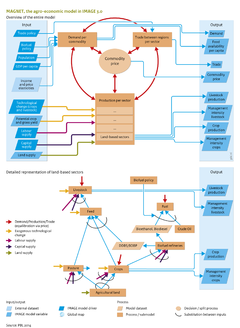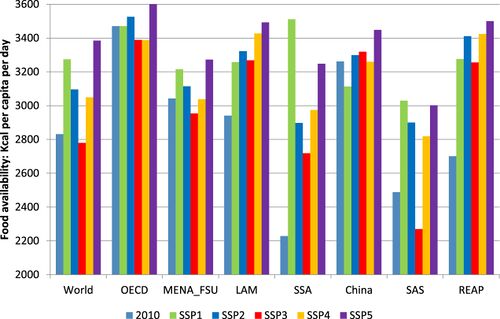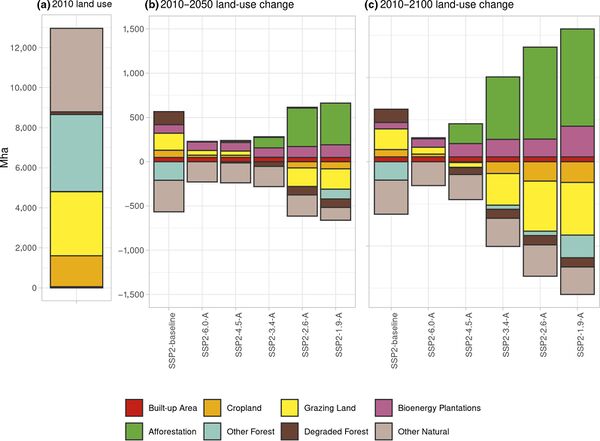Agricultural economy/Policy issues
Parts of Agricultural economy/Policy issues
| Component is implemented in: |
|
| Related IMAGE components |
| Projects/Applications |
| Key publications |
| References |
Baseline developments
In a baseline scenario, agricultural crop and livestock production increases rapidly driven by population increase and dietary changes. This is also the case in baseline scenarios shown in the figure below that are based on FAO projections, and on MAGNET and IMPACT calculations (Stehfest et al., 2013). As a consequence of production increases, the total area of cropland and pasture is projected to increase, although this is less certain. Depending on scenario and region, some baseline scenarios may also show decreasing land areas, certainly after 2030 when the population starts to decline in several regions.
Policy interventions
Numerous policy interventions can be studied with the linked IMAGE-MAGNET and IMAGE-IMPACT framework:
- Biofuel policies: Partly as an autonomous process under high oil prices but mainly driven by biofuel policies, the proportion of biofuels (so far, only first generation) in the transport sector is projected to increase (Banse et al., 2008). The model can be used to estimate direct and indirect land-use change and associated emissions.
- REDD policies: Forest protection leads to a reduction in CO2 emissions from land-use change. The related opportunity costs can be used to estimate cost curves for the emission abatement that results from REDD policies (Overmars et al., 2014).
- Agricultural and trade policies can be assessed for their effects on land use, greenhouse gas emissions and biodiversity (Verburg et al., 2009).
- Measures to reduce biodiversity loss by increasing protected areas, increasing agricultural productivity, dietary changes, and reducing waste (PBL, 2010). Several biodiversity options, in a stepwise introduction, affect land and commodity prices as well as land-use change (the figure below).
- Consumption changes, dietary preferences, and their effect on global land use, prices and emissions can be studied (PBL, 2011; Stehfest et al., 2013)
Changes in crop and livestock production systems, such as more efficient production methods, or organic farming can be assessed (PBL, 2011; Westhoek et al., in preparation).
Effects of policy interventions on this component
| Policy intervention | Description | Effect |
|---|---|---|
| Afforestation policies (*) | Increasing forest area to sequester CO2 in biomass which helps to achieve stringent climate targets. (Reference:: Doelman et al., 2020) | Reduces agricultural land use in regions with cost-optimal afforestation leading to higher food prices, lower food availability and changes in trade. |
| Agricultural trade policies (*) | Changes in agricultural trade policies are applied to the corresponding quota (export or import quota) or border taxes. (Reference:: Verburg et al., 2009) | Impact of this policy intervention is a change in trade between regions, and consequently a change in production within a region for the different crop and livestock sectors. |
| Changes in consumption and diet preferences (*) | Interventions that target consumption changes or changes in dietary preferences (Reference:: Stehfest et al., 2013) | Changes demand for certain products, and subsequently production and trade of that product. |
| Changes in crop and livestock production systems (*) | General changes in crop and livestock production systems, e.g. more efficient production methods to create higher production per unit of input, or other systems like organic farming | Effect of this bunch of interventions is a change in the relation between the use of external inputs (capital), land and labour. For livestock systems the intervention can result in the use of more feed instead of grazing. For cropping systems it could, for example, express the use of more fertilizer to increase yields (closing the yield gap). |
| Closing the yield gap (*) | This intervention increases actual yields (reduces the gap between potential and actual yields), usually realized by better management. | Higher yields reduce the need for agricultural land and usually lower the price of food commodities. |
| Enlarge protected areas | Increase in areas with protected status, as well the size of the areas as the numer of parks. (Reference:: PBL, 2010) | Expansion of protected areas decreases the available area for agriculture in certain regions. |
| Implementation of biofuel targets (*) | Policies to enhance the use of biofuels, especially in the transport sector. In the Agricultural economy component only 'first generation' crops are taken into account. The policy is implemented as a budget-neutral policy from government perspective, e.g. a subsidy is implemented to achieve a certain share of biofuels in fuel production and an end-user tax is applied to counterfinance the implemented subsidy. (Reference:: Banse et al., 2008) | Obligatory biofuel blending increases the demand for biofuel crops, e.g. maize and oil crops, which causes higher prices. Secondly, production will be increased and/or demand for food will decrease, due to these higher prices. Production can be increased by increasing external inputs, labour or land expansion. |
| Implementation of land use planning | Application of zoning laws or cadastres, assigning areas to certain land uses. | This intervention can decrease available area for agriculture in certain regions. |
| Intensification or extensification of livestock systems | A change in the distribution of the production over pastoral and mixed systems; usually to a larger share of the production in mixed systems, which inherently changes the overall feed conversion ratios of ruminants. | An intensification of livestock systems decreases the average area needed per animal (in land using livestock systems) |
| Intensification/extensification of livestock systems | A change in the distribution of the production over pastoral and mixed systems; usually to a larger share of the production in mixed systems, which inherently changes the overall feed conversion ratios of ruminants. | An intensification of livestock systems decreases the average area needed per animal (in land using livestock systems) |
| Non-CO2 taxation policies (*) | Taxes greenhouse gas emissions in agriculture to achieve cost-optimal mitigation in the agricultural sector. (Reference:: Frank et al., 2019) | Reduces production of emission-intensive agricultural products and impacts consumption and trade-flows. |
| REDD policies (*) | The objective of REDD policies it to reduce land-use related emissions by protecting existing forests in the world; The implementation of REDD includes also costs of policies. (Reference:: Overmars et al., 2012) | Increases the cost for land expansion in certain regions, favouring the use of other external inputs to increase production. |
| Reduction of waste/losses (*) | Reduction of losses in the agro-food chain and waste after consumption. (Reference:: PBL, 2010, PBL, 2012) | Reduction in losses and/or waste decrease the demand for agricultural commodities and consequently production. |
(*) Implemented in this component.


